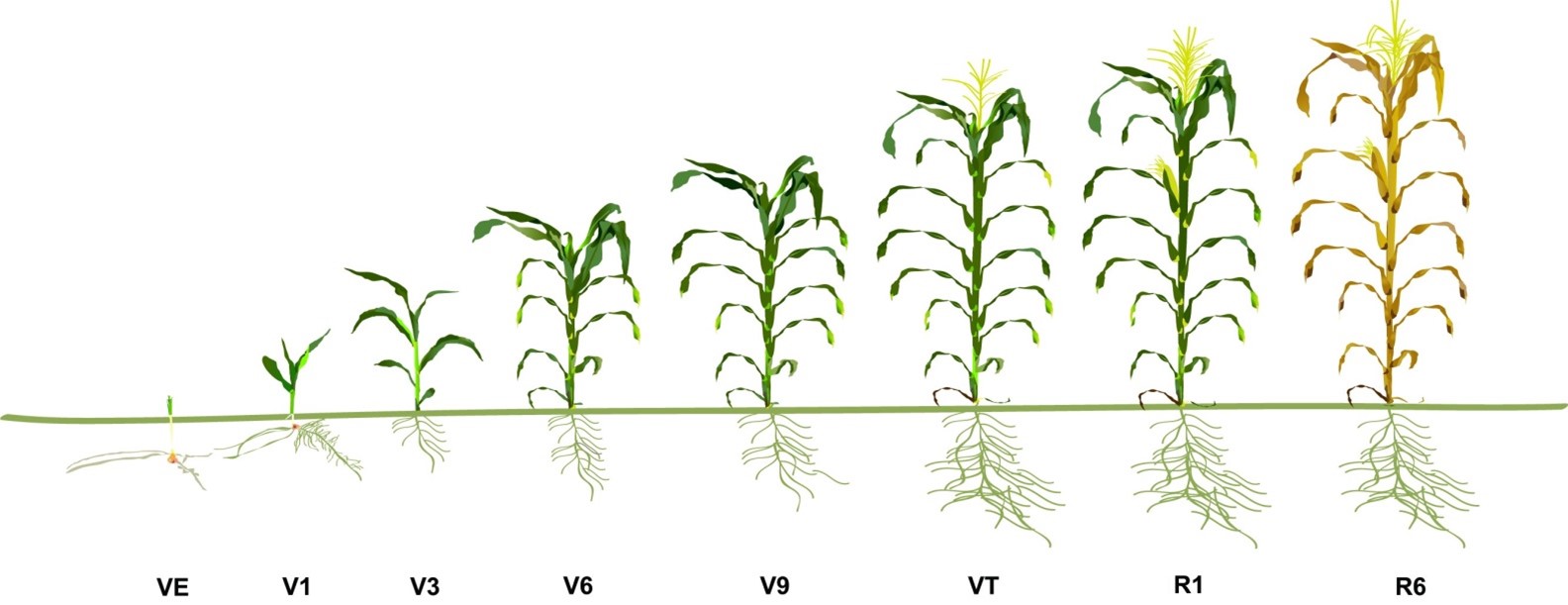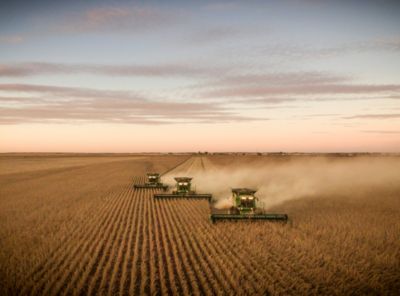Corn Growth Stages Defined
Growth stages of corn are divided into vegetative stages (V) and reproductive stages (R) as outlined in Table 1. Subdivisions of the V stages are designated numerically as V1, V2, V3, etc. through V(n), where (n) represents the last leaf stage before VT for the specific hybrid under consideration. The first and last V stages are designated as VE (emergence) and VT (tasseling). The number of leaves (n) will fluctuate with hybrid and environment differences. The vegetative stages and six subdivisions of the reproductive stages are designated numerically with their common names in Table 1.
Table 1. Growth and development stages.
Vegetative Stages
|
Reproductive Stages
|
VE = emergence
|
R1 = silking
|
V1= first leaf collar
|
R2 = blister
|
V2 = second leaf collar
|
R3 = milk
|
V3 = third leaf collar
|
R4 = dough
|
V(n) = nth leaf collar
|
R5 = dent
|
VT = tasseling
|
R6 = maturity
|

Staging a Corn Seedling
Each leaf stage is defined according to the uppermost
leaf whose leaf collar is visible. The first part of the collar that is visible is the back, which appears as a discolored line between the leaf blade and leaf sheath. The characteristically oval-shaped first leaf is a reference point for counting upward to the top visible leaf collar as demonstrated in Figure 1.

Figure 1. V3 corn plant
Staging Larger Plants
Beginning at about V6 increasing stalk and nodal root growth combine to tear the small lowest leaves from the plant. Degeneration and eventual loss of the lowest leaves results. To determine the leaf stage after lower leaf loss, split the lower stalk lengthwise (Figure 2) and inspect for the internode elongation. The first node above the first elongated stalk internode generally is the fifth leaf node. This internode is usually a little less than ½ inch in length. This fifth leaf node may be used as a replacement reference point for counting to the top leaf collar.

Figure 2: Staging after V6
Plant Height
Some herbicide labels refer to the stage of development of corn based on plant height or leaf stage. Corn height is generally defined as “free standing” or the height of the arch of the highest leaf that is at least 50% developed. Corn height is less accurate than leaf number in determining growth stage.
Reproductive Growth Stages
Tassel (VT) – bottom-most branch of tassel completely visible and silk has not emerged.
Silking (R1) – silks visible outside the husks
Blister (R2) – kernels white on outside, clear liquid inside.
Milk (R3) – kernel yellow outside, milky white fluid inside.
Dough (R4) – kernel fluid thick/pasty, cob pink or red.
Dent (R5) – most kernels at least partially dented.
Physiological Maturity (R6) – milk line no longer evident, black layer formed. Maximum dry weight is attained.

Rate of Development
Emergence may occur as rapidly as 4 or 5 days after planting in warm moist soil or may take 3 weeks or more in cool soils. A new leaf will appear about every 3 days during early growth, while later leaves developing during warmer conditions may appear in 1 to 2 days. Full season hybrids in the central Corn Belt typically can produce 21 to 22 leaves. Earlier maturing hybrids will produce fewer leaves. The rate of development after pollination is given in Table 2. Bear in mind that development may be faster than suggested here under higher than normal temperatures or slower under lower than normal temperatures.
Table 2. Days after pollination for reproductive growth stages.
Kernel Growth Stage
|
Days After Pollination
|
Pre-blister
|
9
|
Blister
|
13
|
Early Milk
|
17
|
Milk
|
21
|
Late Milk
|
25
|
Soft Dough
|
30
|
Early Dent
|
35
|
Dented
|
40
|
Late Dent
|
45
|
Half Milk Line
|
50
|
Mature
|
55
|
The foregoing is provided for informational use only. Please contact your Pioneer sales professional for information and suggestions specific to your operation. Product performance is variable and depends on many factors such as moisture and heat stress, soil type, management practices and environmental stress as well as disease and pest pressures. Individual results may vary. Pioneer® brand products are provided subject to the terms and conditions of purchase which are part of the labeling and purchase documents. FF160524 (200727)
May 2016











